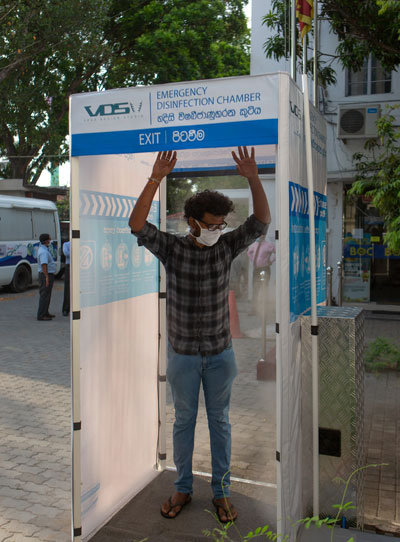News
Unique disinfection chamber which uses ozonized water
View(s):
The Vega Design Studio - Disinfection Chamber. Pic by Sameera Weerasekera
A simple ceremony in the garden of the Health Ministry on Tuesday evening was the only activity in the launch of an important item in the battle against COVID-19 – the Vega Design Studio – Disinfection Chamber.
It is the only disinfection chamber in the country with the unique feature of using ozonized water rather than alcohol or chemicals which could be harmful to the human body and not environmental-friendly, said the Health Ministry’s Colombo Regional Director Dr. Indika Jagoda.
He said this disinfection chamber is good to be located in any public place or at the entry of any office complex because it takes only 20 seconds for the whole disinfecting process to take place for the whole body, all outer surfaces including the shoes.
Under this collaborative project, Dr. Jagoda came up with the idea for such a disinfection chamber, the ozonized water concept was introduced by a team from the Sri Lanka Institute of Nanotechnology (SLINTEC) under the guidance of Manju Gunawardena and the chamber was manufactured by Dr. Harsha Subasinghe of VEGA, manufacturers of electric cars.
Material on the Vega Design Studio – Disinfectant Chamber reveals that it is the only chamber in Sri Lanka with certified test results. It has been built with internationally recognized water disinfection treatment technology.
The chamber requires 220v electricity and a water line connection only and no other chemical. It operates on fully-automated mode, with no push buttons necessary. This simplifies the process of long-term deployment and saves potentially hundreds of thousands of rupees.
It is at SLINTEC that the disinfection chamber had been tested. With the testing for virus disinfection, particularly the highly infectious new coronavirus, not being a viable option, it had been tested for bacterial disinfection, it is learnt.
“This is valid because ‘enveloped’ viruses such as the new coronavirus are easier to kill using disinfection liquids than bacteria,” says Dr. Jagoda, giving the average disinfection rate from the chamber as being 92%.
The Sunday Times gets a glimpse of how the testing was done – a cultured bacteria had been applied on a life-size plastic test dummy, after which, to measure the baseline of bacteria, a swab test had been performed on multiple areas including the head, chest and hands.
Next the disinfection had been turned on for 20 and 40 seconds, after which further swab tests had been carried out. The dummy had not been rotated or moved, like a human would be able to do during disinfection.
Rotation and movement while disinfection is going on, it is safe to assume, would give better coverage for disinfection during regular operation, Dr. Jagoda said.


